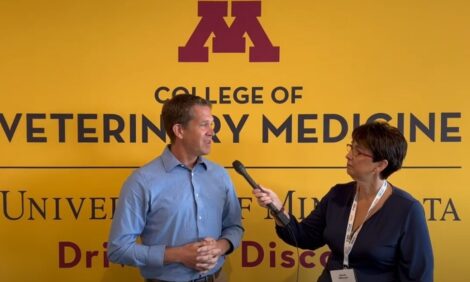



When swine medicine crossed over to human medicine
The tools used countless times to eradicate disease in sow herds and on hog farms became the tools to help pork packing plants reopen last spring after shutting down due to COVID-19. In an unusual turn of events, swine medicine crossed over to human medicine and helped quell COVID-19 outbreaks among plant workers and their families.Veterinarians involved in the unprecedented effort spoke in a session at the 2021 American Association of Swine Veterinarians meeting. Tim Loula, DVM, led the effort with help from Paul Yeske, DVM, both of Swine Vet Center, St. Peter, Minnesota. Also closely involved were David Bomgaars, DVM, with RC Family Farms, Orange City, Iowa, and Brad Freking, DVM, New Fashion Pork, Jackson, Minnesota.
Plant closures
“When we started to hear about the COVID-19 problems, never did we imagine that slaughter capacity would be the biggest challenge that many producers and veterinarians would have to deal with,” Bomgaars related.
While pork-processing plants were deemed essential and could stay open during the pandemic, COVID-19 outbreaks sparked alarm among workers, their communities and local government officials. Soon, plants in Minnesota and Iowa cut back production and some completely closed.
A growing backlog of market hogs created great alarm in the pork industry. Producers and veterinarians worked on ways to handle backlogs while waiting for processors to reopen. But the processors didn’t know when that would happen.
Connecting with medical teams
“It just seemed like nobody was doing anything to get an answer on how to get these plants back running,” Bomgaars said. “Tim Loula and I discussed the need to get the human medical community involved in this process. We needed to better understand the prevalence, exposure, severity and asymptomatic rate of COVID-19.”
Bomgaars started seeking connections in the medical community. He contacted the CEO of his local hospital in Orange City and was provided a connection with Sanford Health, a major medical system in Sioux Falls, South Dakota. Sanford’s chief medical officer was willing to work with Bomgaars and other veterinarians to develop a plan for testing workers and getting packing plants back in operation.
“The medical doctors’ response was very encouraging,” Bomgaars related. “I was also talking with Roger Main, DVM, at the Iowa State University (ISU) Veterinary Diagnostic Lab. It was taking the state hygienic lab 10 to 12 days to get COVID-19 tests completed. The ISU lab has been running over a million PCR (polymerase chain reaction) tests a year. They helped the hygienic lab expand to run PCR tests. There was tremendous collaboration with human-health providers in Iowa.”
Both Loula and Bomgaars discussed their experiences eliminating disease in a hog population with the medical doctors. They explained how they used testing to assess the infection and immunity in populations of hogs. This same process could be used to assess COVID-19 infections in workers.
“Dr. Loula’s basic premise is we need to get testing and build confidence in what’s occurring so people will come back to work,” Bomgaars said. “Through collaboration with veterinarians, epidemiologists and health care providers, he developed a testing algorithm.”
The COVID-19 algorithm
The algorithm is a roadmap for handling COVID-19 test results and getting packing plants open (link to algorithm). All workers are tested either with a PCR or antibody test. Those testing positive on the PCR must quarantine and retest weekly until negative, which is when they can return to work. Workers who test negative can work unrestricted but must continue to be tested on a regular basis.
Workers testing positive on the antibody test must follow-up with a PCR test, according to the algorithm. If the PCR is negative, they can go to work. But if the test is positive, they must quarantine and be retested weekly by PCR until they have a negative test.
“This plan was to test everyone and keep them from spreading to other workers,” Bomgaars explained. “It definitely helped keep other processing plants operating.”
Workers were managed according to their health status to decrease health risk and promote worker safety. The negative PCR and immune (positive antibody test, negative PCR test) populations could work together. Initially it was proposed that these workers and families were housed in hotels or dorms to stay safe. The positive PCR with positive antibody test were at very low risk of shedding if showing no clinical signs. They were segregated in the plant or worked different shifts from the rest of the population.
“In the initial testing, it was amazing how many workers were asymptomatic,” Bomgaars said. “One plant had 2,400 people tested with 40% PCR positive and well over half showing no clinical signs. At another plant, 370 workers tested positive, and all were asymptomatic.”
Building worker trust
The algorithm helped packing plants get back in operation. And those that didn’t close were able to stay at near capacity by taking steps to test and manage workers to stop the spread of the disease.
“We also noticed a very personal response with education and explanations about the situation in languages that people could understand,” Bomgaars added.
During the really tough times of the pandemic, gift certificates were purchased from local restaurants for take-out food and given to plant workers. On weekends, Bomgaars said they had truckloads of food brought in and donated to the workers, too.
“Doing things that show you care about their health and family had a major impact on worker confidence that you want to do what’s best for them,” he added. “That’s a huge thing we learned in this process.”
The veterinarians also took home some good lessons about working with their human medical counterparts. “Local health workers understood that veterinarians are used to population medicine, and human medicine is more attuned to individuals,” Bomgaars explained. “They learned new methods of thinking. And the synergy that occurred in those situations was remarkably good. We may need this again.”






